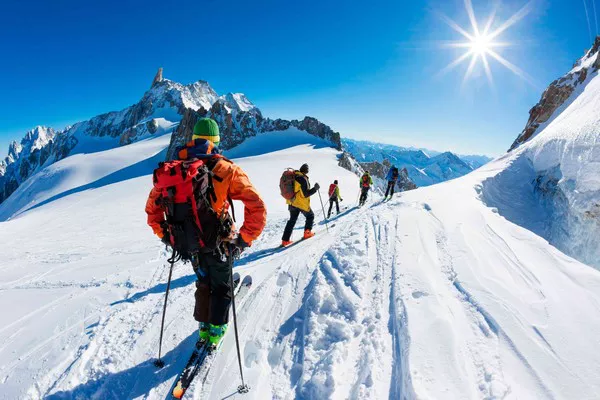In the realm of adventure sports, few activities match the sheer exhilaration and challenge of ski mountaineering. Combining elements of skiing and mountaineering, this multifaceted discipline offers enthusiasts a unique opportunity to traverse rugged terrain, ascend imposing peaks, and descend pristine slopes—all while immersed in the breathtaking beauty of remote mountain landscapes.
Understanding Ski Mountaineering
At its core, ski mountaineering, often referred to as ski touring or backcountry skiing, involves ascending and descending mountains using skis. Unlike traditional skiing, which typically takes place within the confines of groomed resort slopes, ski mountaineering ventures into untamed, unmarked terrain. Participants rely on their own physical strength, technical skills, and navigational expertise to navigate through diverse landscapes, ranging from glaciated peaks to dense forests.
The Essence of Ski Mountaineering
Ski mountaineering embodies a harmonious blend of athleticism, exploration, and appreciation for the natural world. Unlike other adrenaline-fueled sports, such as downhill skiing or snowboarding, which prioritize speed and technique, ski mountaineering places a premium on self-sufficiency and environmental awareness. Participants embark on journeys that require careful planning, meticulous preparation, and a deep respect for the inherent risks of mountain travel.
Key Components of Ski Mountaineering
Ski mountaineering encompasses a wide range of skills and techniques, each essential for success in the backcountry. These include:
Skiing Proficiency: While prior skiing experience is beneficial, ski mountaineers must adapt their technique to navigate varied terrain and snow conditions. This may involve mastering techniques such as kick turns, side slipping, and traversing steep slopes with confidence and control.
Alpine Climbing Skills: Beyond skiing, ski mountaineers must possess basic mountaineering skills, including the use of crampons, ice axes, and rope systems for ascending steep or icy terrain. Knowledge of avalanche safety and rescue techniques is also crucial for mitigating the inherent hazards of backcountry travel.
Route Finding and Navigation: Unlike marked ski trails, backcountry terrain often lacks clear signage or established routes. Ski mountaineers must rely on map reading, GPS navigation, and terrain assessment to safely navigate through complex landscapes, avoiding hazards such as crevasses, cliffs, and avalanche terrain.
Equipment Selection and Maintenance: Choosing the right gear is paramount in ski mountaineering, where equipment must balance performance, durability, and weight. Skis, bindings, boots, and climbing skins are selected based on the specific demands of the terrain and weather conditions. Regular equipment maintenance is essential for ensuring reliability and safety in remote environments.
The Appeal of Ski Mountaineering
Despite its inherent challenges, ski mountaineering continues to attract enthusiasts from all walks of life. The allure lies in the opportunity to explore untouched wilderness, escape the crowds of resort skiing, and experience a profound connection with nature. Whether embarking on a multi-day expedition or a day trip to a nearby peak, ski mountaineering offers a sense of adventure and freedom that is unparalleled in other winter sports.
Environmental Stewardship and Conservation
As interest in ski mountaineering grows, so too does the need for responsible stewardship of our mountain environments. Recognizing the fragile ecosystems and pristine landscapes that serve as the backdrop for their adventures, many ski mountaineers are actively involved in conservation efforts and advocacy for sustainable recreation practices. This includes minimizing environmental impact, practicing Leave No Trace principles, and supporting initiatives to preserve mountain habitats for future generations to enjoy.
Conclusion
Ski mountaineering represents the pinnacle of outdoor adventure—a fusion of athleticism, exploration, and reverence for the natural world. As enthusiasts continue to push the boundaries of what is possible in the mountains, the allure of ski mountaineering will endure, inspiring new generations to embark on their own journeys of discovery amidst the snow-capped peaks and alpine vistas of the world’s most spectacular landscapes.
FAQs:
1. What is ski mountaineering race?
A ski mountaineering race, also known as skimo, combines skiing and mountaineering. Participants ascend and descend mountains using skis, often in challenging terrain and varying snow conditions. The races can range from short, intense sprints to longer endurance events. Competitors typically use lightweight equipment, including skis, boots, and bindings optimized for both climbing and descending. The objective is to efficiently navigate the course, which may involve steep ascents, technical descents, and potentially carrying gear.
2. How do you climb a mountain with skis?
Climbing a mountain with skis involves several techniques. Skiers use skins, which are specialized strips attached to the base of skis, providing traction for uphill travel. They employ a technique called skinning, where skis grip the snow during the ascent, allowing climbers to move forward. Additionally, ski mountaineers may use ski crampons for extra grip on icy slopes. Climbing routes vary based on terrain and snow conditions, with skiers often following switchbacks or direct ascents, depending on the slope’s steepness.
3. How do you walk with skis?
Walking with skis involves a technique called skiing or gliding. Skiers slide their feet forward in a gliding motion while keeping their skis parallel or in a V-shape to maintain stability. Poles are used for balance and propulsion, alternating with each stride. Skiing on flat terrain or gentle slopes requires less effort, while steeper slopes may involve controlling speed and direction using turning techniques such as snowplowing or parallel turns. Proper weight distribution and balance are crucial for efficient and safe skiing.

